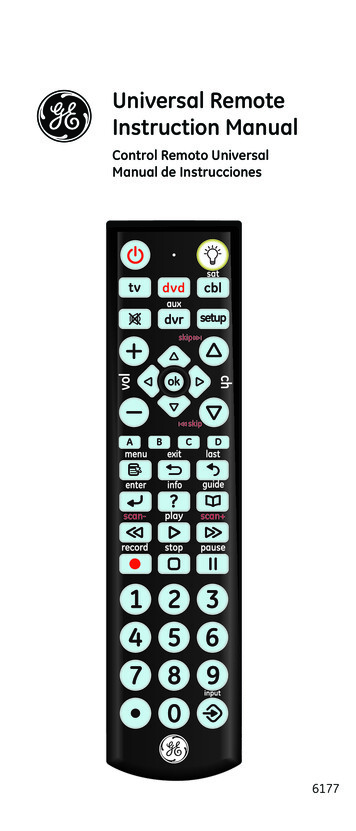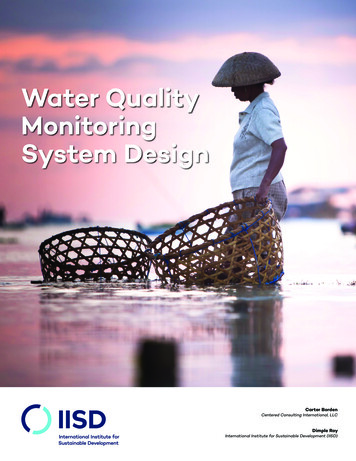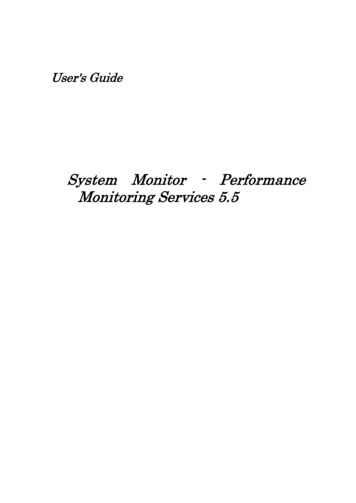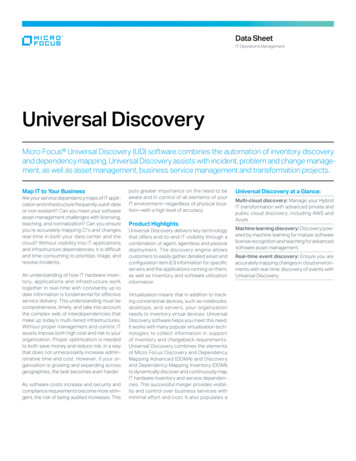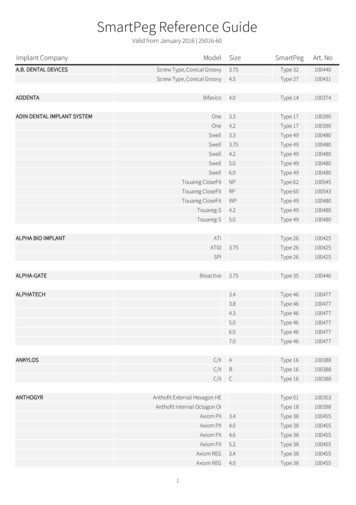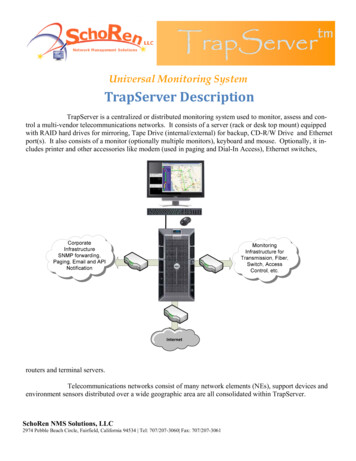
Transcription
tmTrapServerUniversal Monitoring SystemTrapServer DescriptionTrapServer is a centralized or distributed monitoring system used to monitor, assess and control a multi-vendor telecommunications networks. It consists of a server (rack or desk top mount) equippedwith RAID hard drives for mirroring, Tape Drive (internal/external) for backup, CD-R/W Drive and Ethernetport(s). It also consists of a monitor (optionally multiple monitors), keyboard and mouse. Optionally, it includes printer and other accessories like modem (used in paging and Dial-In Access), Ethernet switches,routers and terminal servers.Telecommunications networks consist of many network elements (NEs), support devices andenvironment sensors distributed over a wide geographic area are all consolidated within TrapServer.SchoRen NMS Solutions, LLC2974 Pebble Beach Circle, Fairfield, California 94534 Tel: 707/207-3060 Fax: 707/207-3061
tmTrapServerUniversal Monitoring SystemTrapServer gathers state-of-health information from multi-vendor NEs either directly orthrough a variety of vendor supplied Remote Terminal Units (RTUS) connected to the devices. The informa-SchoRen NMS Solutions, LLC2974 Pebble Beach Circle, Fairfield, California 94534 Tel: 707/207-3060 Fax: 707/207-3061
tmTrapServerUniversal Monitoring Systemtion is provided real-time to Operator/Users through various TrapServer displays and reports. Operators andTechnicians can respond quickly to equipment problems and often can prevent network failures.Information is reported by TrapServer on TrapServer Manager in graphical displays(AreaViewer) and textually as a change of status (EventViewer) or through the optional Browser GraphicsView. Additionally, information can be sent to other X11 Client Workstations users, emailed or users loggedin through a PC using TrapServer Browser Access. Information can also be optionally sent to other manage-ment systems using SNMP or APIs, Paging Users (Alphanumeric and Beeper) and Printers. All of this allowsmultiple operator/users and field technicians, both locally and remotely located from TrapServer, access to network information which will affect the quality of service (QoS) TrapServer users provide their end users.TrapServer can also remotely control network devices. For example, TrapServer operator canmanually send a control/command to force an NE to use a different communications channel or TrapServercan be configured to automatically send a control/command based on a combination of alarm status. Thesefeatures truly provide end-to-end management of our customer’s communications network in real time.SchoRen NMS Solutions, LLC2974 Pebble Beach Circle, Fairfield, California 94534 Tel: 707/207-3060 Fax: 707/207-3061
tmTrapServerUniversal Monitoring SystemOptionsTrapServer has several options that can be purchased to extend its functionality. Those options are;Paging/AOR:Users are notified based on configured criteria relating to Area-OfResponsibility with escalation. This eliminates the notification getting lost in acrowd because only the users that have a need to know are notified. It the trouble persists, escalation is provided.Email notification is included with TrapServer and requires access to a SMTPserver for outgoing notifications. Use of SMS can be used and requires access toan additional SMS service provider.Dial-In Browser Access:Users can call into TrapServer with PC/Laptop equipped with any browser toview conditions, acknowledge an event or actuate a control.Protocol Module:TrapServer enables users of Badger 481 Remote Terminal Units (analog or digital communications), Larse (aka Badger) 1200 series Remote Terminal Units(analog or digital communications) and of Alcatel-Lucent microwaves systemequipped with MCS-11 protocol to poll for detected alarm conditions (contactSchoRen NMS Solutions, LLC2974 Pebble Beach Circle, Fairfield, California 94534 Tel: 707/207-3060 Fax: 707/207-3061
tmTrapServerUniversal Monitoring Systemclosures and analog threshold violations). Users of these modules are also ableto locally/remote “Select-Scan” to receive real-time updates of contact closuresat a site and analog voltage readings from the site.MODBUS protocol is an “open” bit oriented protocol supported by TrapServerand used by devices generally installed within a building or process control environment. MODBUS protocol is included in this section.RedundancyIn support of a Disaster Recovery Plan, TrapServer provides Redundant TrapServer. All interface modules are supported. In the event of a designated primaryTrapServer, the secondary takes over. Provides continuous reception and display of alarm events!SNMPPro:Enables TrapServer to poll any SNMP object to receive alarm event information.Events detected are assigned a priority with Date and Time received. Events arealso able to be assigned a unique icon within AreaViewer.TrapServer SMT:TrapServer SNMP Message Translator (SMT) manipulates traps. The following components of a trap PDU can be converted: Version (v1 to v2c and v2c to v1)IP Address / host nameEnterprise OIDHost Table (multiple hosts, simultaneously)The benefit of these trap manipulations is that they allow the traps to fit an existing trap processing scheme. For example, if a NOC has an SNMP manager thatexpects a certain OID, then the TrapPro can be configured to insert that OID intoall traps. Now the NOC SNMP manager is monitoring the traps and no administration was necessary. It can be added to a Linux system and does not needTrapServer.Printer:Reports can be printed at predefined printer locations.Interface Module:TrapServer monitors intelligent data from network elements. Data presented toTrapServer usually is presented in the form of ASCII, TL1 or TBOS. Data isparsed looking for keywords, phrases or text (could be pages) and once detected,an event is registered with Time and Date, and Priority along with information tothe site, device, element and description of the event.SchoRen NMS Solutions, LLC2974 Pebble Beach Circle, Fairfield, California 94534 Tel: 707/207-3060 Fax: 707/207-3061
tmTrapServerUniversal Monitoring SystemTrouble-Ticket:Trouble-Ticketing is automatically issued with the pertinent information of a service affecting event and technician dispatched. Web based viewing/reporting ofTrouble-Ticket facilitates tracking of faulty equipment and/or services to ensuremaintaining and the improvement of your QOS. Dispatchers/Operators/Technicians have access to their specific Trouble-Ticket to provide status updates toward the recovery of the event. Great tool for managing your people,managing your repair inventory and most of all, your QOS!Multiple Monitors:Up to four monitors can be added to TrapServer to expand the display of our users’ monitored network.Browser Area Views:Browser StatusView enable users who have dial-up or internet access to readilysee an Area to determine current site and alarm status at a glance! All alarms areshown graphically as individual icons that reflect the color of the assigned alarmpriority and are arranged in an Area assigned to sites. Users view alarm activityby changes in normal and alarm priority color as the alarms change state.Custom:Each and every communications users are unique and have varied needs formonitoring of their network. TrapServer is designed to meet and exceeds yourneeds. Custom interface modules and custom reports are available to TrapServerperfectly into your needs. Just let us know!SchoRen NMS Solutions, LLC2974 Pebble Beach Circle, Fairfield, California 94534 Tel: 707/207-3060 Fax: 707/207-3061
tmTrapServerUniversal Monitoring SystemTrapServer SoftwareOperating System Software;Red Hat Linux 64, Enterprise Release 5 of newer, TrapServer Operating System and includesX11 server for X11 Client Workstations and Web Server for access by TrapServer users for Reports and System Operations. Other tools provide by Red Hat are Python which provides our unique interface modules forparsing alarm data unique to individual NEs that are provided with TrapServer or customer developed aftertraining.TrapServer Application Provides;AreaViewer AreaViewer is a Graphical User Interface (GUI) that is configured to provide a visual indication of monitored system. Depending on the size of the system, these icons represent Area(containing sites and devices, also defining areas of responsibilities), Sites (containing devices)or the specific device. Lower GUI levels can include Area (containing Site, device and entity). Device level contains the equipment monitored and the icon of the event being monitored contained within the device. Each level can have its own level map/drawing /picture/photo assigned to it. Icons represent the status of the site with color representing the alarm pri-ority assigned (Color of highest alarm over-rides lower alarm priorities) with flashing Iconsrepresenting newly received alarms.SchoRen NMS Solutions, LLC2974 Pebble Beach Circle, Fairfield, California 94534 Tel: 707/207-3060 Fax: 707/207-3061
tmTrapServerUniversal Monitoring SystemAreaViewer also provides the capability of Area-of-Responsibility (AOR). AOR will filter Areas and Events based on the login user and filter forwarding of traps (TrapForwarding) basedupon Area, Site, and Equipment configuration. This feature enables Enhanced Email & Pagingdescribed within “Email Paging Manager”.EventViewer Event View displays all events in “real time” as it is reported. This window is divided withHistory (top) and Current/Standing Events (bottom). As events are detected, the event is placedin both windows in the color which matches its priority. Once the event clears, the event is removed from the Current/Standing Events (bottom) but the clear is placed in the top window.Web Reports TrapServer enables http:// or https:// secure (using IP port, unique password and User Name)access to Standing Events and History Reports using the html browser on your PC in the officeSchoRen NMS Solutions, LLC2974 Pebble Beach Circle, Fairfield, California 94534 Tel: 707/207-3060 Fax: 707/207-3061
tmTrapServerUniversal Monitoring Systemor outside the company intranet. Color of text identifies event priority within Standing Eventsand History reports.Additional Standard Reports include; Trouble Tickets, Monitored Device Status, Device EventSummary, Total Event County by last 30 days and Monthly for last 12 months, Event Durationby Week/Month, Nuisance Event (passes through definable algorithm) and Device Availability.Customized report generation is also available.What can I do with TrapServer?TrapServer displays your network’s status using a graphical display and text messages. Also,TrapServer employs a WEB Server for access by authorized managers, engineers, technicians and operators toobtain network status data in the form of html reports. Graphical Elements generally are represented in a waythat makes the most sense to your operations. With a designed graphical construction, the location and natureof network problems are quickly discernible.TrapServer is equipped with email notification and optionally, a paging interface (alphanumericand beeper). Both functions allow users to be assigned areas within the monitored network and to be automatically notified when a device has an alarm event.Acknowledge ConditionsWhen the alarm event is first reported, it is considered “Unacknowledged” and the graphicalrepresentation of the condition is visibly flashing with the color that reflects the priority of the event. Additionally, the Area where the alarm occurred within the Browser Panel flashes too. If the Browser Pane Tree isexpanded (to Site, Device and/or Element), the respective “icon” flashes too and enables the operator to“zoom” quickly to the alarm event rather than clicking to lower levels.When the alarm event is acknowledged, the icon ceasing flashing and remains the color of theevent should it still be in an alarm. When the user acknowledges a network condition, the acknowledgementstatus is reflected by all TrapServer user interfaces.Why Acknowledge?The difference between an “Ack’ed” alarm condition and an “UnAck’ed” alarm condition can determine what actions TrapServer and users should take.SchoRen NMS Solutions, LLC2974 Pebble Beach Circle, Fairfield, California 94534 Tel: 707/207-3060 Fax: 707/207-3061
tmTrapServerUniversal Monitoring SystemMost networks experience latency between the notification and resolution of a fault condition. The latency may vary depending upon the nature of the problem. Acknowledgement allows TrapServer userto identify that a particular network condition has been notices and is being acted upon. This preventsconfusion that might lead to other users of TrapServer to duplicate costly notification procedures, unaware that the condition is being addressed.Another benefit of acknowledgment is that the visibility of the standing condition is subdued in comparison with newly reported events. This is particularly valuable where TrapServer is not constantlymanned. Any user approaching TrapServer or remotely accessing TrapServer can quickly determinewhere network activity has occurred.Acknowledge from the fieldWhen TrapServer notifies a user to resolve a network condition, it continues the notification until thealarm condition is acknowledged or has cleared. Should no acknowledgement be received, the notification escalates to other recipients. Therefore, acknowledgement is an important procedure for the notified user to perform; it informs all TrapServer users that the condition is being addressed and preventsthe notification of additional personnel for the same problem.Acknowledgement can be performed by the field user by accessing TrapServer’s WEB Server overyour company Intra-Net and a browser or using a PC with browser set up to dial over a dial-in connection.Automatic acknowledgement is available and can be filtered based on priorityControl Your NetworkTrapServer offers the capability of controlling your monitored NE directly using Craft Accessor through the operation of controls relays if using the optional remote terminal unit (Badger 481, Larse 1200or Alcatel-Lucent MCS-11). With Craft Access, you only need to “click” on the monitored NE and you areinstantly connected to the craft interface of that NE whether it is a Terminal Emulation Window, telnet sessionor M2M interface. Craft Access enables you to “talk” directly to the NE without having to connect anotherPC, without having to remember the IP address of the NE or event without having to drive out to the site. CraftAccess excellent way of decreasing your windshield time and is standard with TrapServer.SchoRen NMS Solutions, LLC2974 Pebble Beach Circle, Fairfield, California 94534 Tel: 707/207-3060 Fax: 707/207-3061
tmTrapServerUniversal Monitoring SystemCustomize Your DisplayTrapServer is designed to allow the highest degree of display customization possible withoutrequiring custom software development or a separate graphical display server. A graphical display environment, consisting of a hierarchical window structure, allows the administrator to define the network in the manner most useful to the users. Maps, floor plans, schematic diagrams, photos, or almost any image can be usedas backgrounds for the various levels of display. The point icon is consistent with the textual display of userdefined names.Additionally, each icon (area, site/device, entity, point) has its own note field where free fromtext can be entered to leave status information to subsequent users.Provide Secure AccessEvery TrapServer users is defined with one of several permissions to grant that user specific operations within the system. Access to portions of TrapServer can be granted to specific users, thereby protecting control and configuration functions from unauthorized access. A user must have a valid login and password to access any TrapServer functions. Once logged in, functions and GUI views for which the user has notbeen granted access either do not appear or are not allowed.How Does TrapServer Connect To My Network?Network status is obtained by communicating with NEs and other support devices. A varietyof communications methods may be used, ranging from an IP connection to an NE (SNMP, telnet, TL-1, ASCII), a hard-wired connection between an NEs major/minor relay output and an RTU alarm input, a serial(ASCII/TL-1/Proprietary) data exchange between TrapServer and the monitored NE.Often, the interface to the NE requires the user to define parameters about the monitored equipment, such as the threshold values that determine when a point is considered an alarm (in the case of an RTU)or whether data should be continuously or periodically gathered from an NE or whether collection of data isreceived autonomously from the NE. These parameters are defined in TrapServer and in the event of an RTU.SchoRen NMS Solutions, LLC2974 Pebble Beach Circle, Fairfield, California 94534 Tel: 707/207-3060 Fax: 707/207-3061
view conditions, acknowledge an event or actuate a control. Protocol Module: TrapServer enables users of Badger 481 Remote Terminal Units (analog or digi-tal communications), Larse (aka Badger) 1200 series Remote Terminal Units (analog or digital communications) and of Alcatel-Lucent microwaves system




